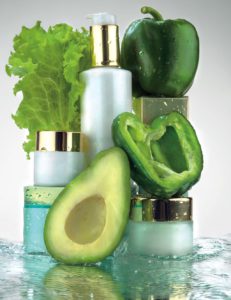 Some of the most difficult ingredients to use in natural cosmetics are emulsifiers and surfactants. There are a number of natural or green surfactants available for cosmetic formulation but these new green compounds bring many technical issues. The market of bio and green products is growing strongly and so are the challenges for the cosmetic brand. There are some disadvantages with natural emulsifiers in that they lack the strength and versatility of conventional or synthetic surfactants. However, technology is advancing very rapidly and new innovative green surfactants are being produced every day.
Some of the most difficult ingredients to use in natural cosmetics are emulsifiers and surfactants. There are a number of natural or green surfactants available for cosmetic formulation but these new green compounds bring many technical issues. The market of bio and green products is growing strongly and so are the challenges for the cosmetic brand. There are some disadvantages with natural emulsifiers in that they lack the strength and versatility of conventional or synthetic surfactants. However, technology is advancing very rapidly and new innovative green surfactants are being produced every day.
The role of emulsifiers, surfactants & emollients
In cosmetic and personal care products surfactants may act as detergents, wetting agents, emulsifiers, foaming agents. In cleaners product such as shampoo, hand soaps and bath products the particular structure of surfactants allows to remove grease and dirt from hair and skin. surfactant mixtures are used in many cosmetic formulation, depend on the mix the solutions have different cleaning properties. Surfactants are good detergents, these molecules are able to lower the surface tension of a liquid and the interfacial tension between liquids. They alter interfacial properties so as to promote removal of a phase from solid surfaces when they are dissolved in water, orient themselves at the interface (boundary) between the liquid and a solid (the dirt we are removing), and modify the properties of the interface.
All the surfactant have a common molecular similarity. One end of the molecule has a long nonpolar chain that is attracted to oil, grease, and dirt (hydrophobe). Another part of the molecule is attracted to water (the hydrophile). When dirt or grease is present (hydrophobic in nature) the surfactants surround it until it is dislodged from the boundary. The chosen surfactant is not only crucial for the effectiveness of products but it be gentle and no irritating for the skin. Emulsifier and emollients are also surfactants. The majority of skin care products and a very significant percentage of toiletry products are emulsions and the basic components of these formulations are emulsifiers, emollients and consistency enhancers. They are essential to produce creams or lotions by enabling oil and water/aqueous components to mix and remain stable over a long period of time. Active ingredients with specific dermatological effects give the value of cosmetic formulation but the selection of these emulsifier and emollients determines also the success of a formulation. The chosen emulsifier is not only crucial for the stability of an emulsion, but has also a large impact on consistency, skin feel and care properties of a formulation. Emulsifi ers have a wide range of applications in cosmetic products.
THE EMULSIFER WORKS IN THE SAME WAY OF A CLEANSER
An emulsion is a dispersion of droplets of a non-miscible liquid in a continuous phase. The polar (hydrophilic) aqueous phase and the non-polar (lipophilic) oil phase of an emulsion cannot be combined in a stable and homogenous way without a surface-active additive like a surfactant. Emulsifiers are interfacially active substances that reduce the interfacial tension between the oil and the water phase. The emulsifier is adsorbed at the interface, giving a fi lm between both phases, which prevents coalescence of neighbouring droplets. Due to its amphiphilic structure, the polar part of the emulsifier has an affinity to the water phase and the non-polar part of the emulsifier to the oil phase.
 Synthetic compounds avoided in cosmetic formulation
Synthetic compounds avoided in cosmetic formulation
Some surfactants are no longer used in green and natural cosmetic products because it causes health and skin problems. The most famous are the SLS’S – Sodium Lauryl Sulphate, this inexpensive detergent in the past was wide used in skin and hair-care products for its detergent and foam-building abilities. SLS and its derivates are known to alter the protective layer of oil on the skins surface and open it up to bacteria. It causes eye irritations, skin rashes, hair loss, scalp scurf similar to dandruff, and allergic reactions. They, therefore, are often formulated with other, milder surfactants to mitigate irritancy potential. In the past few year the formulator are trying to find green alternative to PEG. PEG and its derivates are a surfactant with tickhening propierties it prepared by polymerization of ethylene oxide and are commercially available over a wide range of molecular weights. These molecules have different physical properties (e.g. viscosity) due to chain length effects. In cosmetic product has been known to cause allergic and toxic reactions. This relates to the use of ethoxylation based on petrochemically derived ethylene oxide to produce polyethylene glycol (PEG) derivatives. In addition, some suppliers of raw materials are also promoting products cocamide DEA and coconut diethanolamide free. Cocamide DEA (CDEA), or cocamide diethanolamine, is a diethanolamide made by reacting the mixture of fatty acids from coconut oils with diethanolamine. It is a viscous liquid and is used as a foam boosters and stabilizers in some conventional personal care products. CDEA have been associated with skin allergies by some dermatologists can cause contact allergic dermatitis, particularly on the hands.
Betaine are another surfactant being phased out of many green cleansing products Cocamidopropyl betaine (CAPB) derived from coconut oil and dimethylaminopropylamine is used as a foam booster. It is a medium strength surfactant also used in bath products It is also used in cosmetics as an emulsifying agent and to reduce irritation purely ionic surfactants would cause. However, it would appear that the reported cases may be due to irritant reactions rather than true allergies from impurities such as amidoamine and/or dimethylaminopropylamine in less well-controlled raw materials.
The natural alternatives
Which are optimal green surfactants proprieties? First of all, it should perform as well as equivalent synthetics. Important performance characteristics include foaming capacity, texture and longevity, sensory properties cleansing ability. It should be non-toxic and non-irritating, preferably with an established safe history of consumer use. The green proprieties include biodegradability Owing to the watersolubility of surfactants, they are generally difficult to recover or reuse; therefore, they are discharged as drainage into the environment and syntetich surfactant are are not biodegradable. Some green surfactants have been synthesized using renewable resources, such as amino acids, sugars and organic acids, and they are appropriate to human use because of their low toxicity, high biodegradability high and environmental compatibility. it also very important that this green compounds are produced by green chemistry, a chemistry base on a set of principles that reduces or eliminates the use or generation of hazardous substances in the design and manufacture of chemical products.
In personal care product Saponins are naturally occurring compounds found in a vast number of plant species. Some of the more recognizable plants containing saponins include: quinoa, oats, soy, yucca, quillaja, soapwort, and soap berries. Saponins are classified as glucosides, where hydrophobic alcohols consisting of (sapogenin) and a sugar side chain, joined by an ether bond. The carbohydrate moiety consists of pentoses, hexoses, or uronic acids. The presence of both polar (sugar) and nonpolar (steroid or triterpene) groups provide saponins with strong surface-active properties. Their physiochemical and biological properties feature structural diversity, which have led to a number of traditional and industrial applications. Many saponins are added to shampoos, liquid detergents, toothpastes, and beverages as both an emulsifier and as a long-lasting foaming agent. Natural compound that have made great strides toward the «perfect» naturally derived surfactant are alkypolyglucosides (APGs). These form the major component of many natural cleansing product formulations, as they are mild, biodegradable surfactants produced either from fatty alcohols, i.e., coconut or palm oil-based, and glucose from corn or potatoes.Due to their chemical structure (strong hydrophilic part: glucose residue; hydrophobic part: fatty alcohol residue), they have more superior active pro- perties than other nonionic surfactants. Compared to fatty alcohol ethoxylates, the foaming power of alkyl polyglycosides is clearly stronger.The foaming of most APGs is reasonable is not as rich and copious as conventional SLES/betaine blends. However, the recent introduction of APGs In combination with acyl glutamates, they even produce a foam volume comparable to that of ether SLSs. The new patented process improve foaming properties and rinseability. The issue with APGs in general is their residual feel on skin when used as the sole surfactants in a product. Turning to emulsifiers, for example, lecithins are wide use in food and cosmetic industry. They are group of phospholipids that are found in many plant and animal tissues. they are extracted from soybean, sunflower, egg or milk are an interesting option for green product formulators, and these have long been considered natural, especially coming from the food industry. It is even possible to source organic grades of lecithin; however, lecithin can be challenging and expensive to use. Consisting of long molecules with a hydrophilic head and two lipophilic chains, lecithin has the ability to form protective bi-layers; further, it has a high affinity to skin. Thus, this material can provide additional moisturizing benefits and active ingredient delivery functions. It is also common to combine lecithin, lysolecithin or hydrogenated lecithin with other higher HLB materials or naturally derived gelling agents to form emulsifier blends that are easier to use and have interesting sensory properties. A wide range of naturally derived emulsifiers are available for both o/w and w/o systems, where acceptable green chemistry has been used to produce materials based on natural raw materials such as sugars, hydrophilic acids, coconut, palm oil, milk protein
References
-Natural Standard for Personal Care Products FDA (www.npainfo.org/NPA/NaturalSealCertification/NPANaturalStandardforPersonalCareProducts.aspx)
-Ecocert, Natural and organic cosmetics (www.ecocert.com/en/natural-and-organic-cosmetics COSMOS standard, www.cosmos-standard.org
by E.Brunelli, PhD Biotechnology

